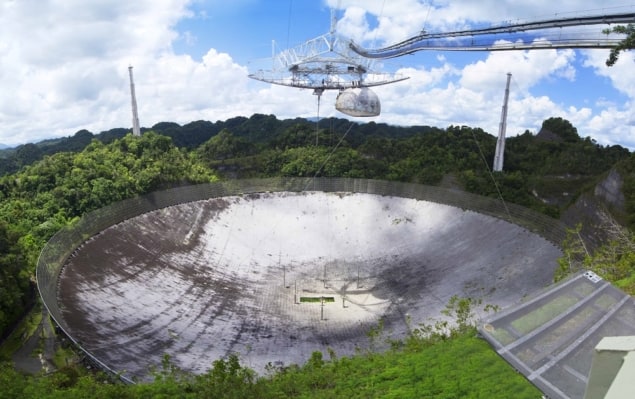
The Arecibo Observatory in Puerto Rico has been saved following an agreement signed by a consortium led by the University of Central Florida (UCF) in Orlando. The announcement was made on 22 February by the National Science Foundation (NSF), which has been looking for an alternative sponsor for the iconic, 305 m-diameter radio telescope since 2006.
The NSF currently spends around $8m a year to keep Arecibo operating. The final impetus for the NSF to find new funding sources came in September 2017 when the telescope was damaged by Hurricane Maria, which caused devastation throughout the island and seemed to sound the death knell for the observatory. Arecibo’s mains electricity was restored in December and operations have since resumed at reduced capacity, while visitors have begun slowly returning to the observatory, which is a tourist attraction on the island.

Arecibo Observatory lives on, but with less money
According to UCF, the new agreement is valued at $20.15m over five years “subject to the availability of funds”, and is scheduled to begin once it assumes responsibility for operations on 1 April 2018. The deal will gradually reduce the NSF’s annual contribution to $2m. “We’re delighted that there are signatures on paper,” says Richard Green, director of NSF’s astronomical sciences division . He adds that it is a “fabulous moment at the end of a long process”.
We are very excited about this new collaboration. I believe together we can do great things and continue to push the boundaries of science
Francisco Córdova, director of Arecibo
The UCF-led consortium, known as the Arecibo Observatory Management Team, includes the Metropolitan University in San Juan, Puerto Rico, and Yang Enterprises in Oviedo, Florida, a company that operates and maintains facilities for both NASA and the US Air Force. Carlos Padin, chancellor of Metropolitan University, says the partnership will “expand the opportunities for research as well as formal and informal STEM education in Puerto Rico”, while Tyng-Lin Yang, vice-president at Yang Enterprises, says the deal would introduce “new technologies and cutting-edge tools” to modernise Arecibo’s operations.
A special place
Although the telescope’s main uses are focused on radio astronomy, space weather and atmospheric science, it is also renowned for its planetary radar facility, which NASA uses for near-Earth asteroid tracking and the characterisation of planetary surfaces. In return, the US space agency makes a $3.7m contribution to Arecibo’s annual budget. According to NASA’s 2018 budget estimate, its Near-Earth Object Observation programme will “continue to fund the operation of the planetary radar capabilities at Arecibo”.

Arecibo Observatory faces uncertain future as boss quits
Ray Lugo, the head of UCF’s Florida Space Institute, notes that the consortium hopes to cover some of its costs by making telescope time available to new users. “We want to bring other customers to the table,” he says, adding that the US Department of Defense could use Arecibo to test sensors while space mining companies may wish to target asteroid candidates using its planetary radar.
“The Arecibo Observatory is a very special place,” adds Arecibo’s director Francisco Córdova. “We are very excited about this new collaboration. I believe together we can do great things and continue to push the boundaries of science”.



